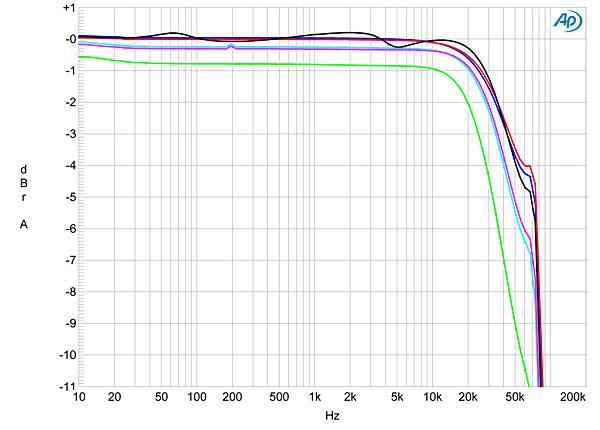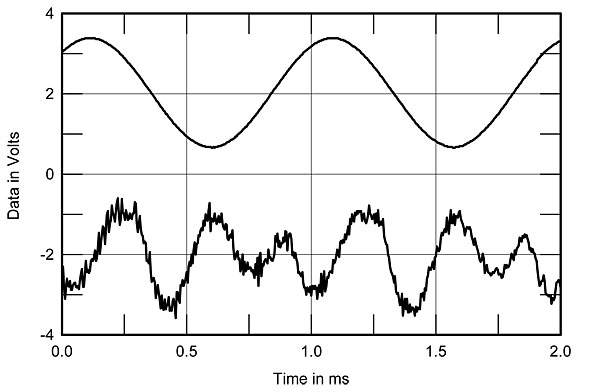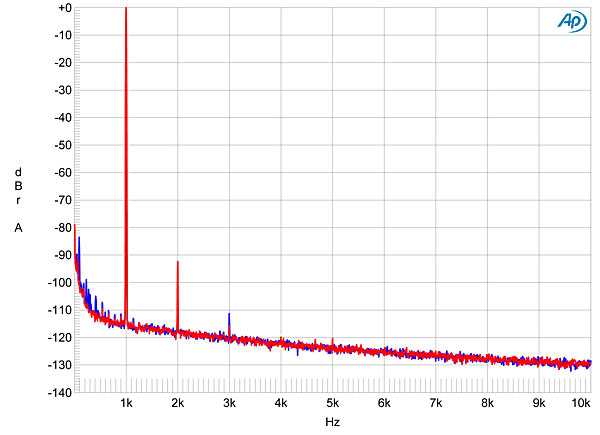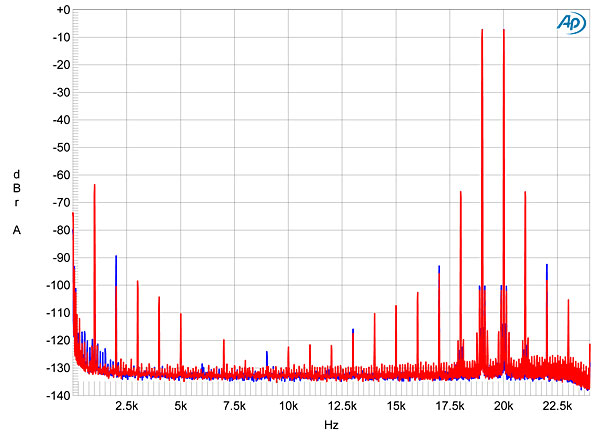| Columns Retired Columns & Blogs |
Quad II Classic Integrated amplifier Measurements
Sidebar 3: Measurements
As always, I used Stereophile's loan sample of the top-of-the-line Audio Precision SYS2722 system (see the January 2008 "As We See It" and www.ap.com) to measure the Quad II Classic. Assessed through its CD input, the Quad's maximum gain was on the low side for an integrated amplifier, at 34.4dB into 8 ohms. Set to moving-magnet, the phono input gave a maximum gain of 76.9dB measured at the speaker output, 42dB measured at the Tape Out jacks. Set to moving-coil, the phono-input gain at the Tape Out jacks was 61.5dB. All the inputs preserved absolute polarity (ie, were non-inverting). With the phono input set to MM, the input impedance was 36k ohms at all frequencies for the CD input and 53k ohms at low and middle frequencies, dropping slightly to 49k ohms at 20kHz for the phono input; at the MC setting, the input impedance was 36k ohms at low and middle frequencies, dropping slightly to 33k ohms at 20kHz.
The output impedance was on the low side for a transformer-coupled tube amplifier, at 0.28 ohm at 20Hz and 1kHz, dropping to 0.2 ohm at 20kHz. As a result, the variation in the amplifier's frequency response driving our standard simulated loudspeaker was respectably low, at ±0.2dB (fig.1, gray trace). The ultrasonic response can be seen to drop off more quickly as the load impedance dropped. Though a residual but well-damped resonant peak is evident at 70kHz, especially into higher impedances, the Quad's reproduction of a 10kHz squarewave (fig.2) produced no visible overshoot. Fig.1 was taken with the volume control at its maximum; the channel matching in this graph is superb and didn't worsen at lower volume-control settings. Though there is a slight mismatch between the channels at low frequencies in the response via the phono input (measured at the Tape Out jacks), the RIAA correction is very accurate (fig.3). However, the phono-stage response does roll off early in the top octave, as well in the low bass below 25Hz.

Fig.1 Quad II Classic, frequency response at 2.83V into: simulated loudspeaker load (gray), 8 ohms (left channel blue, right red), 4 ohms (left cyan, right magenta), 2 ohms (green). (0.25dB/vertical div.)

Fig.2 Quad II Classic, small-signal 10kHz squarewave into 8 ohms.

Fig.3 Quad II Classic, phono input RIAA error (left channel blue, right red; 0.25dB/vertical div.).
Line-input channel separation was okay at 1kHz, at 60dB in both directions (not shown), but decreased to 38dB at 20kHz. The phono input's unweighted, wideband signal/noise ratio was excellent in MM mode, at 63dB ref. 1kHz at 5mV (measured at the Tape Out jacks), but less so set to MC, at 44dB ref. 1kHz at 500µV. The A-weighted ratios were much better, at 81.4 and 64.6dB, respectively. The phono input's overload margin was very good in both modes, at 18–19dB across the audioband.
The Quad II Classic's output transformer seems to be optimized for 8 ohm loads, as that is the load into which it gave the highest power before clipping (fig.4). With our usual definition of clipping as the power when the THD+noise reaches 1%, the Quad delivered 19Wpc into 16 ohms (15.8dBW), 22.2Wpc into 8 ohms (13.5dBW), 14.2Wpc into 4 ohms (8.5dBW), and 8.2W into 2 ohms (3.1dBW). Specified as being able to deliver 25Wpc into 8 ohms (14dBW), the amplifier reached that power at 4.4% THD+N.

Fig.4 Quad II Classic, distortion (%) vs 1kHz continuous output power into (from bottom to top at 1W): 16, 8, 4, 2 ohms.
Fig.4 shows that the Quad II Classic offers very low distortion into higher impedances. I plotted the THD+N percentage against frequency at 5V, equivalent to 3.1W into 8 ohms and 6.2W into 4 ohms (fig.5). There is no rise in THD at low frequencies, testifying to the excellent quality of the Quad's output transformers, and the rise in the top octaves is well controlled, at least into 8 ohms (blue and red traces). The spectral content of that distortion is primarily third harmonic (fig.6). This graph was taken from the left channel; fig.7 shows that in the right channel (red trace) the second harmonic is almost as high as the third, and that higher-order harmonics are also present, though at a very low level. The phono stage offered very low distortion (fig.8), almost all second-harmonic in nature.

Fig.5 Quad II Classic, THD+N (%) vs frequency at 5V into: 8 ohms (left channel blue, right red), 4 ohms (left green, right magenta).

Fig.6 Quad II Classic, 1kHz waveform at 3W into 8 ohms (top), 0.016% THD+N; distortion and noise waveform with fundamental notched out (bottom, not to scale).

Fig.7 Quad II Classic, spectrum of 50Hz sinewave, DC–1kHz, at 5W into 8 ohms (left channel blue, right red; linear frequency scale).

Fig.8 Quad II Classic, MM phono input, spectrum of 1kHz sinewave, DC–10kHz, at 10mV input (left channel blue, right red; linear frequency scale).
Intermodulation distortion was also low. The spectrum in fig.9 was taken at a level just below visible clipping of the waveform on an oscilloscope, but even so, both the second-order difference product at 1kHz and the higher-order products at 18 and 21kHz all lie below –60dB (0.1%). Via the phono input (fig.10), the RIAA equalization brought up the level of the difference product and decreased the level of the higher-order products, but in absolute terms, intermodulation distortion was low.

Fig.9 Quad II Classic, HF intermodulation spectrum, DC–24kHz, 19+20kHz, at 18W peak into 8 ohms (left channel blue, right red; linear frequency scale).

Fig.10 Quad II Classic, phono input, HF intermodulation spectrum, DC–24kHz, 19+20kHz, at 5mV peak (left channel blue, right red; linear frequency scale).
Although it should not be used with loudspeakers whose impedances drop below 4 ohms, the Quad II Classic Integrated's measured performance reveals it to be both a well-engineered amplifier and a very modern tube amplifier, in that it doesn't suffer from the measured ills that plague other tube amplifiers. But I wouldn't have expected anything less from Tim de Paravicini!—John Atkinson
- Log in or register to post comments




































